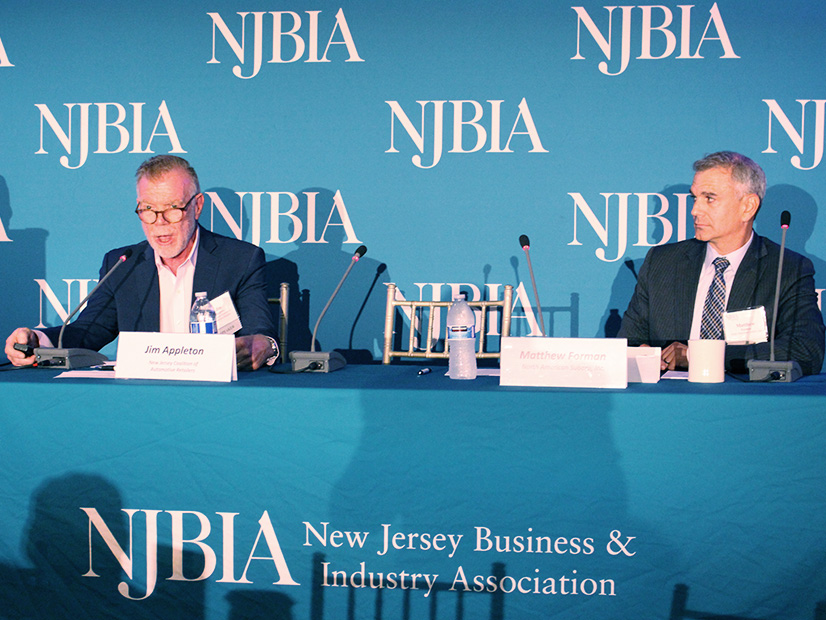
Consumers shy away from buying electric vehicles in New Jersey because of the high price and lack of charging infrastructure, and they’ll still be reluctant even if the state adopts California’s Advanced Clean Cars II (ACC II) rules, representatives of the vehicle sales and manufacturing sectors said at an energy conference last week.
Car manufacturers and dealers said they’re committed to the transition from gas to electric vehicles. But the ACC II rules don’t consider consumer attitudes.
Executives from the New Jersey Coalition of Automotive Retailers (NJ CAR) and North American Subaru voiced their concerns at a conference organized by New Jersey Business and Industry Association (NJBIA).
The ACC II rules require manufacturers to make EVs a steadily increasing portion of their car sales in New Jersey until all new vehicles sales are EVs in 2035. The New Jersey Department of Environmental Protection (DEP), which is accepting public comment on the rules until Oct. 20, is moving to adopt ACC II by the end of the year so they affect the 2027 car model year. The NJBIA is leading a coalition of businesses that oppose the rules. (See NJ’s Push Toward Clean Cars Rule Sparks Vigorous Debate.)
“When a consumer comes into the showroom, and they start shopping for a new car, and they are an ‘EV Intender,’ what winds up happening in the process is that they typically drive out with a hybrid or a plug-in,” said Jim Appleton, president of NJ CAR, referring to a hybrid gas-electric vehicle or a plug-in battery vehicle that also operates with gas.
One reason is that an EV can be $10,000 to $15,000 above the price of a gasoline vehicle, he said. Another reason is the lack of public chargers.
“If they are in a dealership, if they’re a multiple unit dwelling person, if they don’t live in a house with a garage where they can charge their vehicle every night, most consumers are walking out the door because they just don’t trust that the infrastructure is there,” he said.
Matt Forman, director of government and regulatory affairs for Camden, N.J.-based Subaru, said that although New Jersey is reasonably highly ranked in the nation by raw numbers of EVs, its charging infrastructure is lagging. The state is about sixth in the nation by the number of registered EVs, but has only about one charger per 40 EVs, when it needs one per seven EVs, he said.
“That’s the, I’d say, the biggest challenge,” Forman said. “That gap is growing. So for this to succeed, we need to see investment in charging, which traditionally is not the role of an OEM. But you’re starting to see OEMs actually putting money in charging.”
Sales Mandate
New Jersey had about 123,000 EVs in June, according to ChargeEVC, a pro-EV lobbying organization. But that’s a tiny proportion of the estimated 6 million light-duty vehicles registered in the state.
There are about 1,645 Level 2 chargers and 755 Direct Current Fast Chargers in the state, according to the DEP’s Drive Green website. And the state added another $12.7 million to incentive programs designed to encourage developers to install chargers at tourist sites, in multi-unit dwellings and in other locations. (See NJ to Add 400 EV Chargers with $12.7M Investment.)
Although New Jersey has a strong EV purchase incentive program, the weakness in the ACC II is that it focuses on sales to stimulate EV buyers, Appleton said. The regulation starts with a 35% ZEV sales requirement for model year 2026, increasing to 68% in 2030 before reaching 100% in 2035.
“The rule requires manufacturers to send cars, but unfortunately, it doesn’t require consumers to buy them,” he said. “Manufacturers will build what government mandates and they will ship them to dealers who’d be happy to sell them. But the flaw in this program has always been that it lacks a mechanism to require consumers to buy them.”
However, proponents of the rules — including government officials and environmental groups — say climate change requires an urgent, rapid uptake in EV adoption and the ACC II rules will trigger a much faster uptake than the state otherwise would see. Transportation is New Jersey’s biggest emissions source, generating about 40% of greenhouse gases.
Appleton said one impact of the ACC II is that it “corrupts the marketplace,” so that manufacturers will respond to the diminishing number of gas vehicles that can be sold in the state by focusing only on selling higher priced vehicles that give them a larger profit margin. He predicted the state’s dealers nevertheless would suffer as buyers seek gas vehicles out of state.
“I’m sure there’ll be dealers in Idaho, who will be trying to unload their inventory here in New Jersey, and they’ll be reaching out to you and you’ll be able to go online and buy a car in Idaho and they’ll flatbed it here in the state of New Jersey,” he said. “And the dealerships that do business here will lose business.”
OSW Developers Unbowed
In a separate panel, offshore wind (OSW) developers acknowledged the sector faces tougher opposition than in the past, but say they have no intention to back away from a key piece of the state’s energy future.
“I’m not going to sugarcoat it — it is really rough out there on the ground level,” said Crystal Pruitt, external affairs lead for Atlantic Shores Offshore Wind, one of three projects approved by the state. She said it’s difficult “having conversations with communities, having conversations with elected (officials) and policymakers and just seeing the turn of faith away from the policy goals that they were so supportive of.”
The conference followed the release on Sept. 28 of a poll by Stockton University that showed that 50% of those polled support the installation of wind turbines off the New Jersey coast, down from 80% in 2019. The poll was the second to show dramatically diminished support. A Monmouth University Polling Institute poll released on Aug. 29 showed support for offshore wind had dropped from more than 82% in the early 1980s to 54% now. (See Poll Shows Drop in Support for Offshore Wind in NJ.)
New Jersey is in the middle of its third offshore wind solicitation, having backed the 1,100-MW Ocean Wind 1 project in the first, in 2019, and the 1,148-MW Ocean Wind 2 and the 1,510-MW Atlantic Shores projects in 2021.
The polls follow months of growing opposition from Jersey Shore residents and representatives of the tourism and fishing industries who fear the turbines will harm business. Some opponents have seized on a series of whale deaths to boost opposition to the projects, depicting the deaths as potentially tied to the preliminary undersea work underway in preparation for the OSW projects.
State and federal investigators looking into the deaths say there’s no evidence the deaths are linked to the offshore work.
The developers also have faced challenges from rising costs and supply chain difficulties, which have raised questions about the economic feasibility of some projects.
Janice Fuller, mid-Atlantic president of Anbaric, a transmission development company, acknowledged the sector has faced some “negative attention, not just in New Jersey” but in multiple states in recent months. But she cast the downturn as “rationalization” from the unduly high support and expectations early on.
“We were very aggressive, set some really aggressive targets,” she said. “And right now the industry and the world, because of things that are outside of New Jersey’s control, are adjusting. Timelines are being adjusted, prices are being adjusted and a realistic schedule is going to emerge from that.”
“This is a little bit of a bump in the road, unfortunately,” she said, and blamed “misinformation about the industry and its impacts.”

